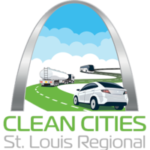MISSION / OVERVIEW
Clean Air and Economic Security
Mission
To advance the nation's economic, environmental, and energy security by supporting local actions to reduce petroleum consumption in transportation and to promote Clean Air, Energy, and Economic Security by using American Made fuels to reduce our dependence on foreign oil.
St. Louis Regional Clean Cities is one of the nearly 100 Coalitions that are part of the U.S. Department of Energy's Clean Cities Initiative, working to reduce our dependence on foreign oil, develop regional economic opportunities, and improve air quality.
Overview
The U.S. Department of Energy (DOE) formally designated the St. Louis metropolitan area as a Clean City in November 1994, based on voluntary commitments to the program made by 32 participating public and private entities. These commitments were delineated in a non-binding Memorandum of Understanding (MOU) signed by DOE and the program participants. The MOU serves as a collective implementation plan.
Awards
Coordinator of the year in 2010. Inducted into the Department of Energy's Hall of Fame in 2011.
WHAT WE DO
Advancing Alternative Fuel Technology
St. Louis Regional Clean Cities (STLRCC) provides a means for coordinating the purchase, refueling and repair of clean-fuel vehicles. STLRCC also affords individual fleet owners and operators the economies of scale offered through bulk purchasing and sharing refueling and maintenance facilities. While Clean Cities is primarily oriented at serving the mutual interest of public and private fleets, the actions taken will make alternative fuel technology accessible to everyone. Alternative fuels include bio-diesel, electricity, ethanol, natural gas and propane.
We partner with stakeholders in the public and private sectors to deploy:
• Alternative and Renewable Fuels
• Idle Reduction Technology
• Fuel Economy Measures; and
• Emerging Transportation Technologies.
St. Louis Regional Clean Cities initiatives spur new demand for alternative fuel vehicle products that in turn, stimulates infrastructure development. These initiatives ultimately assist the national market by challenging the industry to develop product lines and new technologies to meet the constantly changing demands of consumer and fleet vehicle markets.
